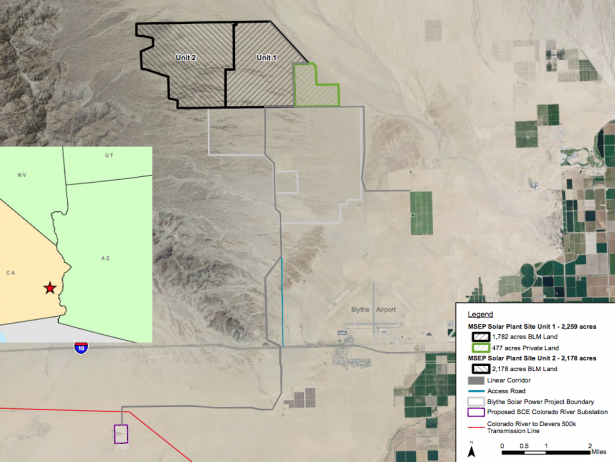Few people might notice the 750-megawatt solar facility proposed for an area of desert land near Blythe, CA, which will provide power for up to 264,000 homes. But tribal leaders say the land contains precious cultural resources that the project would destroy, despite some amendments by the company intended at preserving them.
Now the McCoy Solar Energy Project will be the site of a tribal ceremony on Saturday intended to help maintain the tribes’ footprint on ancestral lands. It is being organized by the Mohave Elders Committee of the Colorado River Indian Tribes (CRIT).
According to CRIT, the land in question contains burial sites, petroglyphs, sacred trails and intaglios that belonged to the ancestors of present-day CRIT members, who lived across a much broader region than the contemporary CRIT reservation.
The solar project, situated on mostly federal land a few miles west of Blythe, has been held up as an example of how renewable energy – solar, wind, etc. – has dropped in cost to the point that it is economically viable as never before. Energy leaders are increasingly looking for good locations for such projects, which also mitigate environmental concerns that fossil fuel plants raise. In the enthusiasm to find such locations, CRIT suggests that the federal Bureau of Land Management has turned a blind eye to tribal concerns.
In a letter to the California Energy Commission back in January, CRIT Council Chairman Dennis Patch wrote, “Shifting the burden of renewable energy development to the unique communities that have occupied this landscape since time immemorial, while providing such communities with no identified benefits, is the very definition of environmental injustice.”
A Commission spokesperson agreed that tribal concerns are legitimate, saying that some areas of public lands are uniquely important to the Tribes. The amendments to the project plans aim to resolve some of the concerns and preserve some of the cultural resources in question.
Saturday’s ceremony will involve tribal singing and other rites and, according to a CRIT flyer, is “sponsored by the CRIT Mohave Elders Committee and NextEra”, the parent company building the solar facility.
 Parker Live News from the Parker Strip since 2009.
Parker Live News from the Parker Strip since 2009.








Something doesn’t pass my smell test. Just my opinion.
That’s because you smell a land grab.
My neighbors yard is uniquely important to me, I’m going to tell him to move away so I can have it.
From the onset while seated on the Tribal Council we took a stand against this site. Unfortunately the Federal judges took a different stance on.this litigation. From discussions my response to them was that it was a gathering place for those people who would congregate around the huge lake formed after the rains. It proved to be that.
RC- I think history shows the land grab was not by Native Americans.
Why is Nextera sponsoring? They are the ones digging up all of the sacred sites.
Who has lived there the last 100 years? The Chemehuevi Indians were in the Blythe about that time and had some trouble with the locals. Go to the Blythe Website. They’ll give you a little history there. Tonopah is a Chemehuevi word. It refers to the area southeast of Salome and north of I-10. There was a “hot springs there. That’s what Tonopah means. Chemehuevis made trips from the Tonopah area, through Blythe, and on to the Palm Springs and Banning area. Even I-10 may have followed their trail…who knows. Just because you walked over an area, built a fire somewhere along the way or maybe took a comfort break, doesn’t make the land sacred. Maybe they’re just trying to get some face time, they’re known for that. Put on their costumes, do a little dance, get some pictures taken and rush home to see if they’re on the six-o’clock news.
Just watch where you do business.